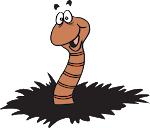With the organic approach you have to be patient and allow nature time to work. This is difficult for me (if you know me, you understand), but I try. A good example of patience is aphids and our plum trees.
 |
| Plum (Stanley) tree. |
A large part of the organic approach is surveying your property. That means walking around and looking at plants to see what's going on. Last week I noticed that there were aphids on the new growth, and that they were starting to make the leaves curl. Some would respond with a spray of poison, but I know better than that. I wanted to grab the hose and spray them all down with a strong stream of water (aphids are weak and many would die with just a strong stream of water knocking them from the leaves).
My plum trees are healthy and can survive a little damage. And, I know that if I leave them (and don't spray poison), the predators will come (and not be killed by the poison). The predators will feed on the aphids and then multiply to make more predators.
Aphids are at the bottom of the food chain, and are prey to a bunch of wonderful beneficial predators (lady bug beetles, predatory wasps, etc.). So, against my nature, I decided to do nothing and let nature work (the population of prey should serve as a magnet for their predators).
 |
| The magnet! |
One week later, and here are the results-- HOORAY!!! The predators are here.
(You may need to click on the photos and enlarge to see the subjects in the following photos.)
 |
| Look closely-- that's an Assassin bug-- SO COOL! They control a wide range of pests. |
 |
| Lady bug beetles. The adults and nymphs eat aphids like grapes. |
 |
| Eggs of something. (If you know what these are, send me an e-mail.) |
 |
| Predatory wasp. |
 |
| A different predatory wasp doing his thing (laying eggs inside the aphids). Just one o'clock from center. |
 |
| Aphids after the predators-- the black aphids show that the predatory wasps have been there and more wasps are on the way. |
The predators responded to the bloom of the aphid population and, because my trees are not coated with poison) they are controlling the outbreak. The predators will multiply and thrive in my yard and surroundings to control future outbreaks (I'm pesticide free, so there is nothing to harm the natural predators-- who control many pests). More importantly, the damage to my trees was very minimal, and I have another reminder as to the many benefits of the organic approach and giving nature time to work.
My next step for these plants is a band of Tanglefoot (on the lower trunk of the trees) keep the ant and caterpillar population down.
I should be enjoying some plums in early September. YUM!
Cheers,
Mark


No comments:
Post a Comment